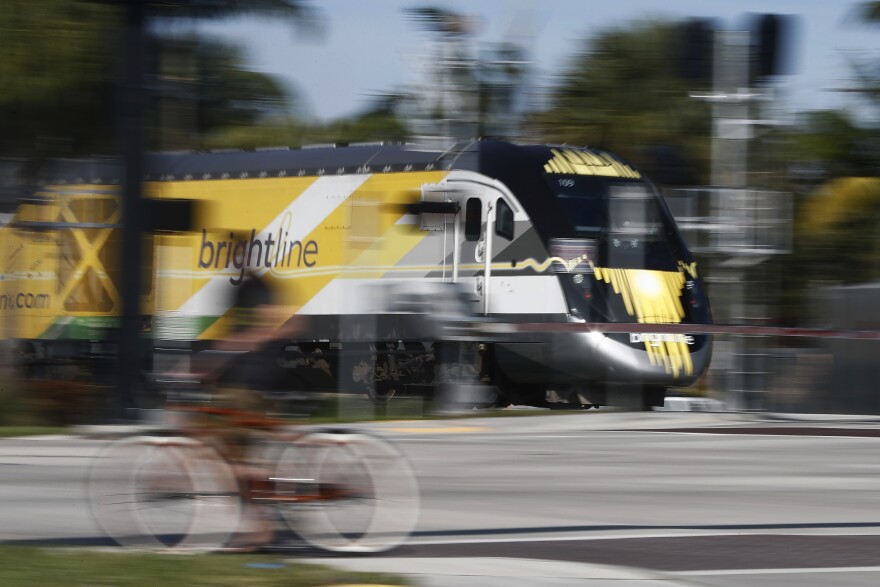More passengers. More revenue — and more spending.
That’s been the business this year for Brightline. It led the passenger train service to see its bond rating cut to junk and talk about selling some of the company to investors to raise money.
“The next one to two years will probably be the most pivotal period to see how (Brightline) really plays out,” said Seth Lehman, senior director at credit ratings agency Fitch Ratings.
Last month, Fitch cut its rating of bonds issued by Brightline into what is commonly referred to as junk bond territory. That’s the riskiest general category for corporate IOUs.
“We put Brightline at the highest rating level that's in the speculative grade,” Lehman explained, “which also means that if they do reverse themselves and they really get to the revenues and the ridership, there's a chance they can get back to that investment grade status.”
Fitch wasn’t alone in expressing its worries about the private passenger train line’s finances. Two other bond ratings agencies also downgraded their views of over a billion dollars of Brightline bonds.
READ MORE: A call for more Brightline safety measures delays quiet zones in Palm Beach County
The concern is that the company is spending its cash faster than anticipated, ridership isn’t growing as fast as expected and train fares aren’t higher..
“The short distance ridership came in well below expectations,” said Fitch lead analyst Ben Munguia.
Short distance rides on Brightline are between Miami and West Palm Beach or somewhere in between.
"The next one to two years will probably be the most pivotal period to see how [Brightline] really plays out."Fitch Ratings Senior Director Seth Lehman
The number of passengers riding Brightline only in South Florida was down almost 8% in the first quarter of this year compared to a year ago. Long distance riders — people catching a train between Orlando and South Florida — were up more than 26%. That was stronger than expected.
Brightline CEO Patrick Goddard explained it to investors last month in a conference call. “ Although we experienced great momentum on long haul growth, we had to work around the displacement of peak shorthaul ridership, who are mostly commuter riders,” he said.
Brightline took seats away from those South Florida commuters so they were available to long distance riders who were paying higher fares. The service effectively hiked commuter fares a year ago when it stopped offering 40 tickets for $400. Instead, the same number of rides went to $1,400.
The average Brightline fare in the first quarter was just over $56. While that was up about 2%, it wasn’t as high as Fitch Ratings expected.
“One thing that we'll be watching over the next year is, is what happens with those average fares and do they start to come back up?” said Munguia.
Fitch also placed Brightline on a negative watch. That’s essentially a warning that its bonds could be downgraded again in the next six months or so.
Brightline Chief Financial Officer Jeff Swiatek called the ratings cut “a disappointment” during that May conference call with investors. “We are focused on addressing the points raised by the agencies so that we can get back to the ratings originally signed to our business,” Swiatek told investors.
Those efforts include ramping up ridership and holding down expenses to improve Brightline’s cash flow. Swiatek said Brightline hopes to secure a large sponsorship deal and sell naming rights to boost revenue. It plans to add more cars to its trains, which will create more seats for it to sell. And it hopes to sell those seats at higher prices.
The train line also may sell part of itself to raise money.
“We're targeting a significant amount of equity coming to the company,” said Ken Nicholson, a managing director at Brightline’s owner, Fortress Investment Group.
Nicholson did not expand much on the possibility of selling some of the company to other investors “other than to say we have commenced engagement with third parties.”
Brightline is the only private intercity passenger rail company in the U.S. Its total revenue last year was $188 million, more than double from a year earlier. But its operation costs also increased and the service has yet to turn an operational profit. Brightline lost $153 million on its operations in 2024. Its net loss grew to over $500 million.
In its 2024 annual report, Brightline reported total assets of $5.8 billion, most of it in its 235 miles of rail lines and train equipment. It has a little over $2 billion in debt.
Despite its new junk bond status, the company has more than a year's worth of interest payments due to lenders set aside.






